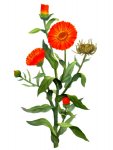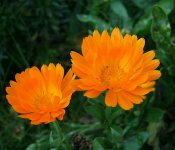Calendula officinalis (calendula officinalis) - calendula officinalis l.
Family Asteraceae - Compositae
Botanical characteristics. Family Compositae. Annual herbaceous plant with slightly branched stem root, height up to 40-60 cm. Leaves are back-ovate, alternate, light green in color. Orange-yellow beautiful large flowers are located on the tops of stalks and lateral processes, collected in baskets. Blossoms in June-August, fruits ripen in July-September.
Spread. It is grown for medical purposes in the southern regions of the European part of the country, in the Caucasus, and also in the Moscow region. It is popular with fans of floriculture, as an ornamental plant is found in gardens and parks throughout Russia.
Used parts of the plant.
Flower baskets and reed flowers.
In various parts of the plant, triterpene saponins, bitterness, tannins, mucus, essential oils, phytoncides, large amounts of carotene and carotenoids, flavonoids and alkaloids have been found.
Application.
It is widely used in folk and scientific medicine. Calendula calms the nervous system, somewhat reduces blood pressure, strengthens the heart and slows the heart rate. It is used for neuroses, hypertension, angina pectoris, atherosclerosis and in the climacteric period.
The herb of calendula has a pronounced bactericidal action against streptococci, staphylococcus, and others.
It is used in the treatment of gastritis, gastric ulcer and duodenal ulcer, kidney and bile duct disease, jaundice, pancreatitis, kidney stones and bladder, ulcerative colitis. In folk medicine is considered an antitumor agent.
Especially widely used calendula is external: with diseases of the mouth and pharynx, with wounds, abrasions and trophic ulcers. Flowers are effective in gynecological practice for syringing with erosions, whites and trichomonas colpitis.
How anti-inflammatory is recommended for eye diseases.
Preparation
- Infusion is prepared based on 2 tablespoons of herbs for 2 cups of boiling water. Take 1/2 cup 3-4 times a day before meals.
- For outdoor use, infusion is prepared based on 4 tablespoons of herbs for 2 cups of boiling water.
- M.A. Nosal and I.M. Nosal recommend with a weakening of vision to apply "at night the lotions from napar the following mixture: the flowers of marigolds, the petals of cornflowers and the grass of the eyeballs, taken evenly ... Do not despair of success, are treated for a long time (6 months). It was necessary to observe favorable results of such treatment (it is recommended not to read, write or embroider). "
Irreplaceable plant for florists. Where the yellow flowers of marigold grow, nematodes are not planted in the soil, which are often the cause of mass death of roses.
It is used in homeopathy Calendula 3x, 3, 6, 0, ointment of calendula as an anti-inflammatory and antiseptic agent, with diseases of the liver and gallbladder, for resorption of neoplasms. As an external agent contributes to the appearance of granulation tissue in ruptured and dilated wounds, treats diseases of the nasopharynx and oral cavity, gynecological inflammation.




Comments
Commenting on, remember that the content and tone of your message can hurt the feelings of real people, show respect and tolerance to your interlocutors even if you do not share their opinion, your behavior in the conditions of freedom of expression and anonymity provided by the Internet, changes Not only virtual, but also the real world. All comments are hidden from the index, spam is controlled.